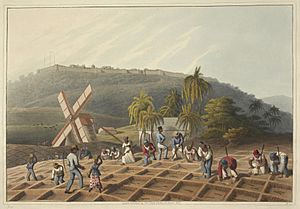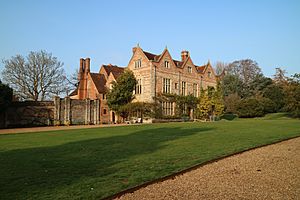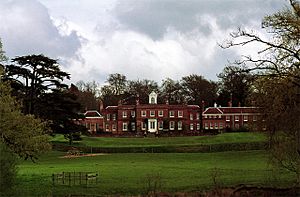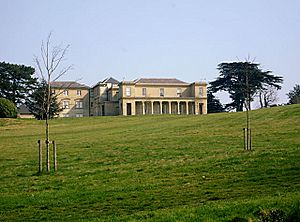Centre for the Study of the Legacies of British Slavery facts for kids
| Type | Research Institute |
|---|---|
| Established | 2010 |
| Director | Matthew J. Smith |
| Location | , |
The Centre for the Study of the Legacies of British Slavery is a research group at University College, London (UCL). It used to be called the Centre for the Study of the Legacies of British Slave-ownership.
The Centre's main goal is to show how British slavery affected people and society. They especially look at what happened after a law was passed in 1837 about paying money to slave owners. All their research is available for free online in a huge database called Legacies of British Slavery.
Contents
How the Centre Started
The Centre began at UCL in 2010. It received help from Harvard University in the United States.
It brought together two earlier projects. The first project, from 2009 to 2012, focused on identifying slave owners. These were the people who received money when slavery ended. The second project, from 2013 to 2015, looked at the history of about 4,000 plantations. These were places where enslaved people were forced to work.
The first project found out that landowners in the British West Indies were paid about £20 million. This was because they were losing their unpaid workers when slavery ended. The second project added another 4,000 plantations and 20,000 slave owners to the research.
Today, the Centre keeps adding information to its database. They want to find all slave owners in the British colonies from 1807 to 1833. This period was when the slave trade was stopped and slavery was finally ended. In 2021, the Centre decided to focus more on the lives of enslaved people. They want to understand their stories, not just the stories of the slave owners.
Who Works There
The first director of the Centre was Nicholas Draper. Catherine Hall was the chair.
In June 2020, Matthew J. Smith became the new director. He used to work at the University of the West Indies. Other important researchers at the Centre include Keith McClelland and Rachel Lang.
The Legacies Database
The Centre's research is available for everyone to see online. It is in the Legacies of British Slavery database. This database lists all the people who received money from the British government. This happened when slavery was abolished in 1833.
Even though the Atlantic slave trade was stopped in 1807, it took many more years for enslaved people in the British Empire to be set free. The government saw freeing enslaved people as taking property from their masters. So, a very large amount of money was paid to thousands of slave owners. Most owners received money for just a few enslaved people. But some families owned huge plantations with hundreds or thousands of enslaved workers. These families received a lot of money.
The first director, Nick Draper, and chair, Catherine Hall, said the database helps stop "selective forgetting." This means society often forgets the terrible human cost of slavery. Instead, it only celebrates when slavery was ended.
The project builds on a wider look at Britain's history with slavery. This re-examination was partly sparked by the 2007 bicentenary. This marked 200 years since the Slave Trade Act of 1807. For example, English Heritage held a conference in 2009. It was about "Slavery and the British Country House." The research showed that links to slavery were often ignored or hidden.
The research for the database found that about 46,000 people received compensation. The total amount paid was huge. It was like £17 billion in today's money. This was the largest payment by the British state until the bank bailout in 2008.
Catherine Hall also explained that not only slave owners benefited from slavery. Many businesses also made money from it. This included merchants involved in industries like sugar processing and textile manufacturing.
One goal of the project is to find out how these families spent their compensation money. Some money paid for the education of sons and grandsons. It also helped them gain more power in their jobs and in politics. For example:
- The person who received the most money was Sir John Gladstone, 1st Baronet. He was the father of a future Prime Minister, William Ewart Gladstone. John Gladstone received over £106,000 for 2,508 enslaved people. This is like £80 million today. Because of this, William Gladstone's first speech in parliament actually defended slavery.
Money was also invested in new industries like railways and factories. It helped build many country houses and art collections. It also funded museums, insurance companies, mining firms, merchants, and banks.
Some streets and statues in the United Kingdom are named after people who owned enslaved people or benefited from slavery. Slavery created immense wealth. For example, the Isle of Dogs in London, where the West India Docks were built, made a lot of money from the slave trade. New Town, Edinburgh is another example.
Slavery's Impact in the United Kingdom
Guy Hewitt, who was the High Commissioner of Barbados in London, compared this project to the Trans-Atlantic Slave Trade Database. This database is run by the Emory Center for Digital Scholarship.
The BBC broadcast a two-part TV show called Britain's Forgotten Slave-owners. It was presented by historian David Olusoga. The show won a BAFTA award and a prize from the Royal Historical Society.
Many organizations that existed during the time of slavery are now looking into their past. They want to find any connections to slavery. For example, the University of Glasgow started an investigation. They want to understand how slavery affected their institution. Some businesses that still exist today have been shown to have benefited from slavery. These include the Bank of England, Lloyds, Baring Brothers, and P&O.
Slavery's Impact in Australia
Scholars have also used the Centre's work to study Australian colonial history. The database has shown many links to slavery that were not known before. For example, the state of South Australia might owe its start to money from slavery. George Fife Angas and Raikes Currie gave large sums of money. Without this money, the colony would not have been created in 1836. This research got a lot of attention in the news.
Another Australian state, Victoria, also had many former slaveholders and people who benefited from slavery in its history. Some of these people are still honored today with place-names and statues.
Slavery's Impact in the United States
Actor Ben Affleck apologized after it was revealed he tried to hide his family's connection to slavery. This connection was found using the Legacies database.
See also
- List of slave owners
- Reparations for slavery





